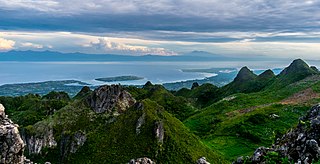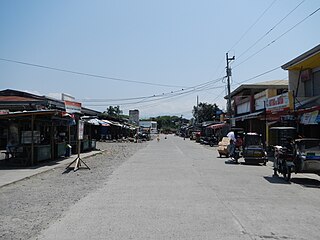
Cebu, officially the Province of Cebu, is a province of the Philippines located in the Central Visayas (Region VII) region, and consists of a main island and 167 surrounding islands and islets. Its capital and largest city is Cebu City, nicknamed "the Queen City of the South", the oldest city and first capital of the Philippines, which is politically independent from the provincial government.

Tarlac, officially the Province of Tarlac, is a landlocked province in the Philippines located in the Central Luzon region. Its capital is the city of Tarlac. It is bounded on the north by the province of Pangasinan, Nueva Ecija on the east, Zambales on the west and Pampanga in the south. The province comprises three congressional districts and is subdivided into 17 municipalities and one city, Tarlac City, which is the provincial capital.

Nueva Ecija, officially the Province of Nueva Ecija, is a landlocked province in the Philippines located in the Central Luzon region. Its capital is the city of Palayan, while Cabanatuan, its former capital, is the largest local government unit (LGU). Nueva Ecija borders, from the south clockwise, Bulacan, Pampanga, Tarlac, Pangasinan, Nueva Vizcaya and Aurora. The province is nationally known as the Rice Granary of the Philippines, producing the largest rice yield in the country.

La Libertad is one of the departments of El Salvador and is located in the southwest of the country. The capital is Santa Tecla. It has an area 1,653 km² and a population of more than 747,600 people.

Cabiao, officially the Municipality of Cabiao, is a 1st class municipality in the province of Nueva Ecija, Philippines. According to the 2020 census, it has a population of 85,862 people. Cabiao is the 3rd most populous, one of the richest, and fastest growing municipality in the province, only behind Talavera and Guimba. If cities are included, the town ranks 6th.

Cabanatuan, officially the City of Cabanatuan, is a 1st class component city in the province of Nueva Ecija, Philippines. According to the 2020 census, it has a population of 327,325 people, making it the most populous city in Nueva Ecija and the fifth-most populous in Central Luzon.

Talavera, officially the Municipality of Talavera, is a 1st class municipality in the province of Nueva Ecija, Philippines. According to the PSA Census of Housing and Population for 2020, it has a population of 132,338.

San Jose, officially the City of San Jose, is a 3rd class component city in the province of Nueva Ecija, Philippines. According to the 2020 census, it has a population of 150,917 people.

Libon, officially the Municipality of Libon, is a 1st class municipality in the province of Albay, Philippines. According to the 2020 census, it has a population of 75,073 people.

Roxas, officially the Municipality of Roxas, is a 1st class municipality in the province of Isabela, Philippines. According to the 2020 census, it has a population of 65,839 people.

Maria Aurora, officially the Municipality of Maria Aurora, is the only landlocked and 2nd class municipality in the province of Aurora, Philippines. According to the 2020 census, it has a population of 44,958 people.

Camaligan, officially the Municipality of Camaligan, is a 4th class municipality in the province of Camarines Sur, Philippines. According to the 2020 census, it has a population of 25,036 people. Camaligan rapidly became an urban town during the 1990s.

Guimba, officially the Municipality of Guimba, is a 1st class municipality in the province of Nueva Ecija, Philippines. According to the 2020 census, it has a population of 127,653 people.

Medina del Campo is a town and municipality of Spain located in the autonomous community of Castile and León. Part of the Province of Valladolid, it is the centre of a farming area.

Isidore the Laborer, also known as Isidore the Farmer, was a Spanish farmworker known for his piety toward the poor and animals. He is the Catholic patron saint of farmers, and of Madrid; El Gobernador, Jalisco; La Ceiba, Honduras; and of Tocoa, Honduras. His feast day is celebrated on 15 May.

The MassKara Festival is an annual festival with highlights held every 4th Sunday of October in Bacolod, Philippines. The festival sites include the Bacolod Public Plaza, the Lacson Tourism Strip and the Bacolod City Government Center.

Quezon, officially the Province of Quezon, is a province in the Philippines located in the Calabarzon region on Luzon. Kalilayan was the first known name of the province upon its creation in 1591. Around the middle of the 18th century, it was changed to Tayabas. In recognition of the second president of the Philippines, Manuel L. Quezon, the name of Tayabas Province is changed to Quezon. Lucena, the provincial capital, the seat of the provincial government, and the most populous city of the province, is governed independently from the province as a highly urbanized city. To distinguish the province from Quezon City, it is sometimes called Quezon Province, a variation of the province's official name.

Tanduyong Festival is an annual harvest festival in San Jose City in the province of Nueva Ecija, the largest province in Central Luzon, Philippines. The festival takes its name from a variety of shallot grown in the region.

The Saint Joseph the Worker Cathedral Parish, also known as San Jose Cathedral, is a Roman Catholic cathedral located at Barangay Rafael Rueda, Sr. Poblacion in the city of San Jose, Nueva Ecija, Philippines. It is the seat of the Roman Catholic Diocese of San Jose in Nueva Ecija and is dedicated to Saint Joseph the Worker.


















